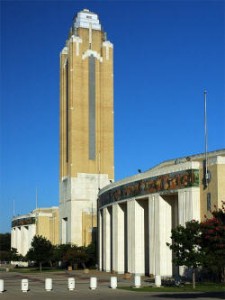 For or against, rich or poor, public welfare has benefited all Americans. Will Rogers Memorial Coliseum in Fort Worth, Texas, where cutting horses and riders are currently headed to compete in the 2012 NCHA Futurity, is a good example. The iconic landmark, as well as economic boon to the City of Fort Worth, could not have been built without federal funds from the Public Works Administration, later known as the WPA.
For or against, rich or poor, public welfare has benefited all Americans. Will Rogers Memorial Coliseum in Fort Worth, Texas, where cutting horses and riders are currently headed to compete in the 2012 NCHA Futurity, is a good example. The iconic landmark, as well as economic boon to the City of Fort Worth, could not have been built without federal funds from the Public Works Administration, later known as the WPA.
“The business of the America people is business,” said President Calvin Coolidge during the Roaring Twenties, a time of rapid economic growth, scant federal oversight, and rampant speculation, as brokers lent small investors two-thirds of the face value of their stock purchases. The historic stock market crash of October 29, 1929 definitively marked the end of the prosperous twenties and the beginning of a dire economic depression.
By 1933, one year after progressive Democrat candidate Franklin Roosevelt soundly defeated incumbent Republican Herbert Hoover, Fort Worth, a bastion of self-reliant conservatives, made its first application for federal funds, which it would continue to rely upon until the beginning of World War II.
Will Rogers Memorial Complex, consisting of the coliseum, as well as an adjoining 208-foot tower and an auditorium, was a beneficiary of these funds, which were supplemented by the City, local leaders, and the US Centennial Commission. It was Texan John Nance Garner, Roosevelt’s vice president, who was instrumental in getting a substantial appropriation from the Centennial Commission. But it was Fort Worth newspaper publisher and civic leader Amon Carter who appealed to his friend, Franklin Roosevelt, for federal funding to construct the coliseum and auditorium to be completed in time for the 1936 celebration of the Texas Centennial.
Although Dallas had been selected as the official site of the Centennial, Carter and civic leaders convinced officials that Fort Worth should be designated as the “Livestock Division” of the celebration, which they dubbed the Frontier Centennial. The domed coliseum, designed by Herbert M. Hinckley Sr., was revolutionary for its time, offering an unobstructed interior view thanks to its unique use of arched steel trusses in the roof. The magnificent 200 x 10-foot tile friezes, running across the upper outside facade of the buildings and depicting people and scenes from Texas history, were designed by Herman Koppe, who was also responsible for other decorative elements reflective of WPA-era architecture, including Art Deco and Moderne style fixtures and motifs.
Coliseum and auditorium construction had barely begun in 1935, when Will Rogers, beloved American humorist, movie star, social commentator, syndicated columnist, and friend to Amon Carter, was killed in a plane crash. Of Cherokee heritage, Rogers was born in Oklahoma and worked his way from cowboy to circus performer to vaudeville and beyond. Yet he never forgot his cowboy roots. When Carter proposed that Fort Worth’s new entertainment complex be named in honor of Rogers, there were some dissenters, but Carter won out.
Fittingly, no one appreciated a good cowhorse more than Rogers, a frequent visitor to Texas, and to the ranch of George W. Saunders, who owned a gotch-earred gelding that Rogers liked to ride. “It was worth the trip to the brush country,” Rogers said, “just to sit above ol’ Gotch and feel his shoulders roll, watch his ears work and his head drop low when he looked an ol’ steer in the eye and dared him to try to get back to the herd.”
